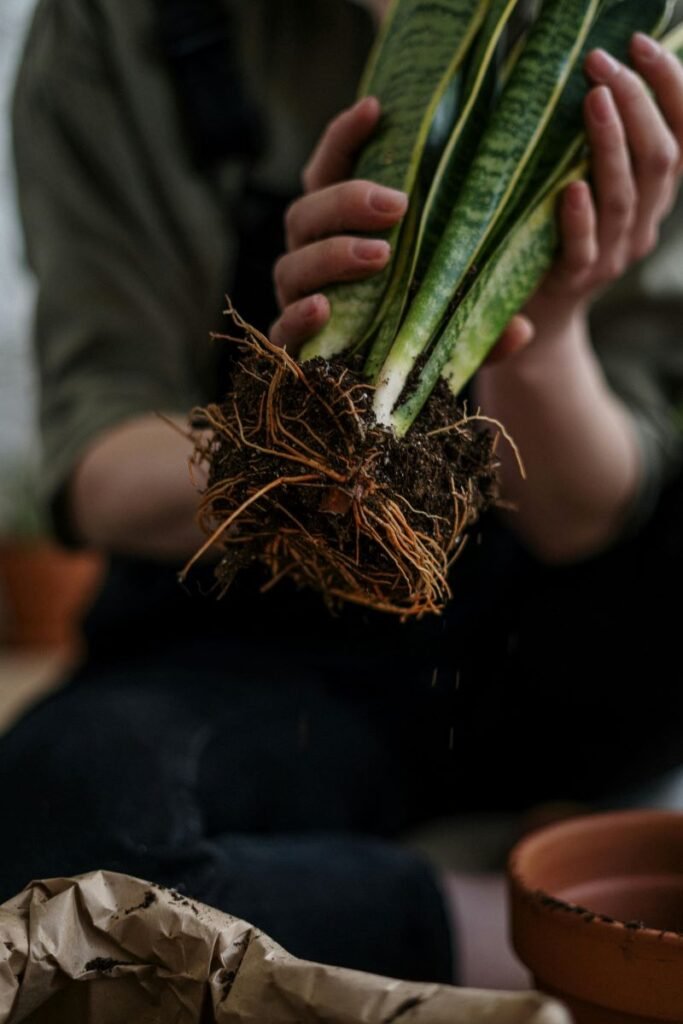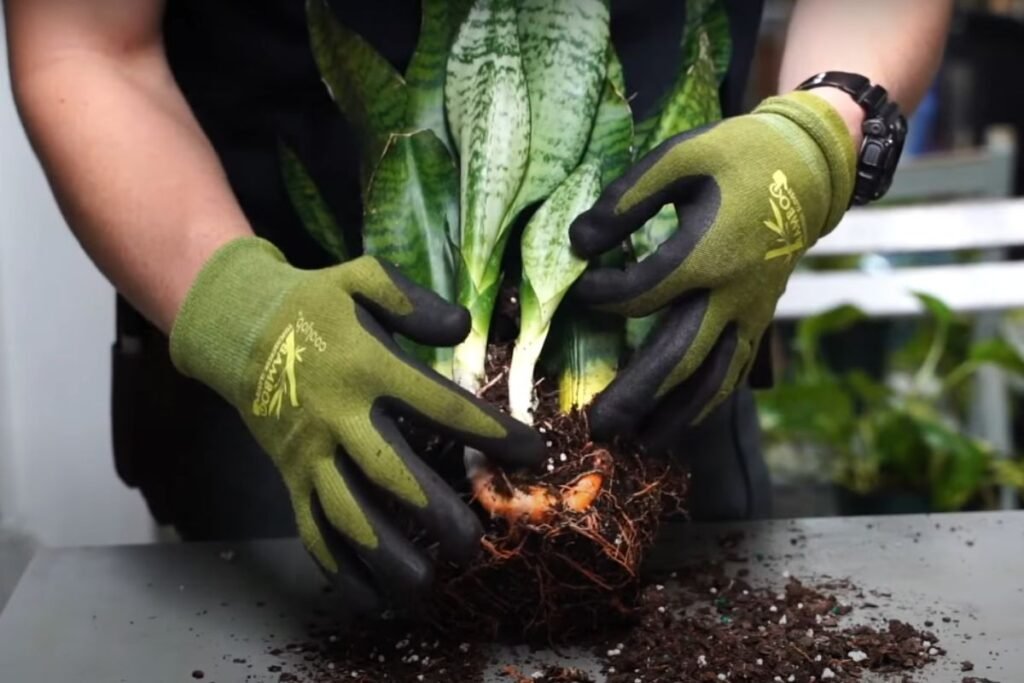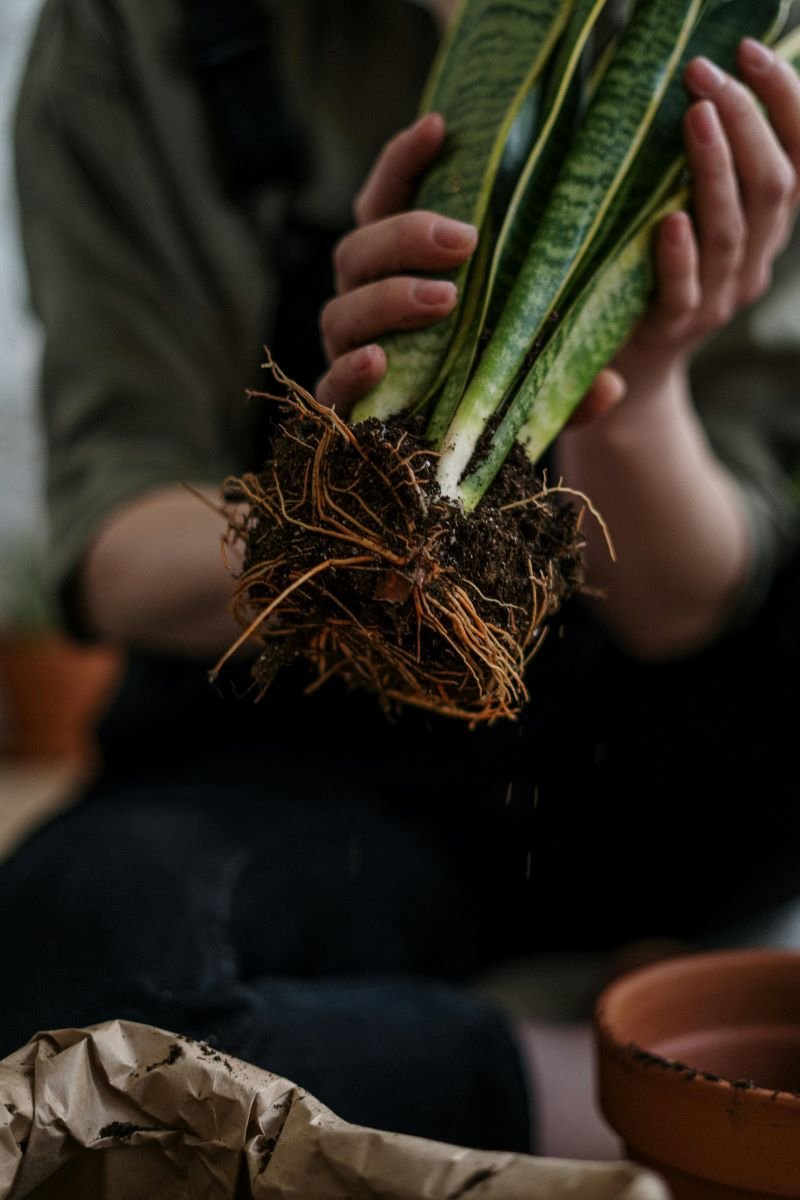We’ve all been there. You go to repot your trusted snake plant after years of faithful service, only to find a tangled mass of roots tightly packed into the shape of the pot. It’s like your plant has made itself a little root sweater! That’s what we call being “root bound,” and for snake plants (Sansevieria), it’s a common situation.
Snake plants are known for their toughness. Many plant parents love them because they can thrive despite neglect. But even these hardy plants eventually need some attention, especially when they start feeling cramped in their pots.
In this post, I’ll share everything I’ve learned about root bound snake plants from my years of growing these architectural beauties. We’ll talk about how to spot the signs, whether it’s actually a problem, and what to do when your snake plant has outgrown its home. By the end, you’ll feel confident handling any root bound situation your snake plant throws at you.

Table of Contents
What Does “Root Bound” Mean?
Simply put, a root bound plant has roots that have grown so much they’ve filled up all the available space in the pot. The roots circle around and around, forming a dense mass shaped exactly like the container.
For many plants, being root bound is a big problem. But snake plants are a bit different. These desert-adapted plants don’t mind being a little snug in their pots. In fact, they often flower more readily when they’re slightly root bound!
But there’s root bound, and then there’s REALLY root bound. When the roots get too packed, even snake plants can suffer. The plant might stop growing, start to look unhealthy, or develop other issues.
Why Snake Plants Often Become Root Bound
Snake plants become root bound for a few simple reasons:
- They grow steadily. While not the fastest growers, snake plants add new leaves and spread underground through rhizomes.
- They have thick, fleshy roots. These storage organs take up more space than the thin roots of other plants.
- We forget to repot them! Because snake plants look fine for years, we often forget they’re slowly filling their pots with roots.
- They multiply. Snake plants produce “pups” or new offshoots that add to the root mass.
Most snake plants need repotting every 2-3 years. But many of us keep them in the same pots much longer. No judgment here—I’ve been guilty of this too!
Signs Your Snake Plant Is Root Bound
How can you tell if your snake plant needs more space? Look for these clear signs:
Visual Clues
- Roots coming out of drainage holes. This is the most obvious sign! When roots start sneaking out the bottom of the pot, they’re telling you they need more room.
- Roots pushing the plant up. Sometimes the root mass gets so packed it actually pushes the plant up higher in the pot.
- Visible roots at soil surface. If you can see roots circling around the top of the soil, that’s another clear indicator.
- Cracked or bulging pot. In extreme cases, the roots can actually crack plastic pots or cause clay pots to bulge.
Growth Changes
- Slowed or stopped growth. A root bound snake plant often stops producing new leaves.
- Smaller new leaves. When new leaves do appear, they might be smaller than older ones.
- Leaning or toppling. The plant becomes top-heavy and may fall over easily.
Health Issues
- Yellowing leaves. When roots are too crowded, they can’t take up nutrients effectively.
- Wilting despite watering. Cramped roots can’t absorb water properly.
- Leaf curling or drooping. This can indicate stress from being root bound.
- Brown leaf tips. This may signal that the plant can’t get enough water.
Watering Changes
- Water runs straight through. If water immediately drains out the bottom without being absorbed, the pot might be mostly roots with little soil.
- Soil dries out very quickly. With less soil to hold moisture, a root bound pot dries faster.
- Top-heavy pot. The pot feels unusually light for its size when dry but gets very heavy when watered.
Is Being Root Bound Always Bad for Snake Plants?
Here’s where snake plants differ from many houseplants—being slightly root bound isn’t always a problem for them. In fact, it can have some benefits:
Potential Benefits of Being Moderately Root Bound:
- More likely to flower. Snake plants often bloom when they’re a bit crowded.
- Less risk of overwatering. Less soil means faster drying, which helps prevent the dreaded root rot.
- More stable growth pattern. A snug plant won’t put all its energy into rapid leaf growth.
- Easier care. Root bound snake plants need watering less often.
However, there’s a tipping point where “comfortably snug” becomes “harmfully cramped.”
When Being Root Bound Becomes a Problem:
- Extremely slow or stopped growth. A little slowdown is fine, but you want your plant to keep growing.
- Difficulty staying hydrated. If the plant can’t retain enough water to stay healthy, that’s an issue.
- Nutritional problems. Severely bound roots can’t access nutrients effectively.
- Risk of toppling. A very top-heavy plant can fall and break.
- Unhealthy roots. When too crowded, some roots may die off from lack of oxygen.
The bottom line? Snake plants can handle being somewhat root bound, but they shouldn’t be completely pot-bound for years on end. It’s a balance!
What Happens If You Don’t Repot a Root Bound Snake Plant?

If you ignore a severely root bound snake plant, several things might happen:
- Growth will stall. The plant simply can’t expand without room for new roots.
- It may start to decline. Leaves might yellow, thin, or develop brown edges.
- Watering becomes tricky. The plant either dries out too quickly or water runs straight through without being absorbed.
- Nutrient deficiencies appear. Without fresh soil, the plant can’t get the nutrients it needs.
- Reduced resistance to pests and disease. Stressed plants are more vulnerable to problems.
- The plant might get “stuck.” When repotting becomes necessary, the root mass can be so tightly bound that it’s hard to remove from the pot without damage.
While snake plants can certainly survive being root bound for quite a while, they won’t thrive in these conditions long-term. Even these tough plants need some care and attention!
How to Check If Your Snake Plant Is Root Bound
If you suspect your snake plant might be root bound but aren’t sure, here’s how to check without causing harm:
Method 1: The Gentle Slide
- Water your plant a day before checking to make the soil easier to work with.
- Place your hand over the soil surface, with the plant stem between your fingers.
- Turn the pot sideways or upside down, and gently tap the edge.
- Carefully slide the entire root ball out.
- If the roots form a dense mass that holds the shape of the pot, your plant is root bound.
Method 2: The Peek-a-Boo
If you don’t want to remove the entire plant:
- Gently dig away a little soil near the edge of the pot.
- Look for a dense wall of roots circling around the pot’s edge.
- If you see mostly roots and little soil, that confirms your suspicion.
What You Might See
Mildly root bound: Some roots circling the outside, but still plenty of soil visible.
Moderately root bound: Dense root mass around the edges, but roots aren’t completely matted.
Severely root bound: Solid mass of roots with the shape of the pot, little to no loose soil, roots densely wrapped around each other.
Extremely root bound: Hard, woody root mass with no visible soil, roots may be growing in a tight spiral, possibly with dead roots in the center.
The level of “root boundness” will help you decide what action to take.
Solutions for Root Bound Snake Plants
Now that you’ve confirmed your snake plant is root bound, what should you do? You have several options depending on your goals and the condition of the plant:
Option 1: Repot into a Larger Container
This is the most common solution and works well when you want your plant to grow larger.
Steps for Repotting:
- Choose a new pot. Go up only 1-2 inches in diameter. Too large a pot can lead to overwatering issues.
- Prepare fresh potting mix. Use a well-draining cactus or succulent mix, or make your own by adding extra perlite to regular potting soil.
- Remove the plant from its current pot. Tap the sides and bottom of the pot to loosen the root ball.
- Loosen the roots. Gently tease apart the outer roots to encourage outward growth in the new pot.
- Trim if necessary. If roots are extremely bound, you may need to trim some outer roots with clean scissors.
- Position in the new pot. Add some soil to the bottom so the plant sits at the right height.
- Fill in with fresh soil. Work the soil between and around the roots, tapping gently to eliminate air pockets.
- Water lightly. Give enough water to settle the soil, but don’t soak it.
Pro tip: Wait a week before watering again to allow any cut roots to heal.
Option 2: Root Pruning and Returning to the Same Pot
If you like the current size of your plant and don’t want it to grow larger, this is a good option.
Steps for Root Pruning:
- Remove the plant from its pot. Just as described above.
- Trim the roots. Using clean, sharp scissors or pruning shears, remove about 1/3 of the root mass. Focus on cutting back the bottom and sides.
- Loosen remaining roots. Gently tease apart any circling roots.
- Add fresh soil. Replace the old soil with fresh potting mix.
- Replant. Put the plant back in the same pot with new soil all around it.
- Water sparingly. Keep the soil just barely moist for a couple of weeks while the plant recovers.
Important note: Root pruning puts the plant under stress. It may drop some leaves or look unhappy for a while, but snake plants are tough and usually bounce back.
Option 3: Division
If your snake plant is both root bound and has multiple crowns or sections, division might be the best solution. This gives you multiple smaller plants!
Steps for Division:
- Remove the plant from its pot. As described above.
- Identify natural separation points. Look for where the plant can be divided into individual plants or sections.
- Separate the sections. You can often pull them apart with your hands, or use a clean knife for tougher cases.
- Trim damaged roots. Cut away any dead or rotting roots.
- Let cuts heal. Allow the divisions to air-dry for a day if you’ve made any cuts.
- Pot up each division. Use fresh potting mix in appropriately sized containers.
- Water lightly. Just enough to settle the soil.
Division is like getting free plants, so it’s a win-win solution when your snake plant has become overcrowded!
Option 4: Do Nothing (Sometimes)
Yes, sometimes the best action is no action, especially if:
- Your snake plant is healthy despite being somewhat root bound
- It’s winter or the plant is flowering (not ideal times to repot)
- You want to encourage flowering
- The plant isn’t severely root bound
In these cases, you can simply:
- Monitor the plant. Keep an eye out for signs of stress.
- Adjust watering. Root bound plants often need more frequent but lighter watering.
- Feed carefully. Use a diluted liquid fertilizer since there’s less soil to hold nutrients.
- Plan to repot later. Perhaps in the next growing season when conditions are ideal.
Aftercare for Repotted Snake Plants
After you’ve dealt with your root bound snake plant, proper aftercare helps ensure a smooth transition:
Immediate Care (First 2 Weeks)
- Light: Keep the plant in slightly less light than usual until it recovers.
- Water: Water very sparingly. The disturbed roots aren’t as efficient at taking up water, making rot a risk.
- Environment: Avoid temperature extremes or drafts that could stress the plant.
- No fertilizer: Hold off on feeding until you see signs of new growth.
Medium-term Care (First 2 Months)
- Gradual return to normal watering. As the plant establishes in its new pot, slowly return to your regular watering routine.
- Monitor closely. Watch for any signs of stress or problems.
- Light reintroduction. Gradually move the plant back to its preferred lighting conditions.
- Light feeding. After a month, you can begin fertilizing at half strength.
Long-term Considerations
- New growth schedule. Your plant may take time to resume active growth after repotting.
- Changed watering needs. In a larger pot with more soil, your watering frequency will likely change.
- Future planning. Make a note of when you repotted so you’ll know when to check again in a few years.
Preventing Severe Root Binding in the Future
While snake plants do fine with some root restriction, preventing severe root binding makes your life easier:
Regular Checkups
Set a calendar reminder to check your snake plant every 1-2 years. A quick peek at the drainage holes can tell you a lot!
Proper Pot Selection
Choose pots with:
- Good drainage holes
- Appropriate size for the plant
- Room for 1-2 years of growth
Timely Repotting
Repot before the plant becomes severely root bound. Spring or early summer is typically the best time.
Monitor Growth Rate
Some snake plant varieties grow faster than others. Variegated types tend to grow more slowly than solid green varieties.
Common Questions About Root Bound Snake Plants
“Do snake plants like to be root bound?”
Snake plants tolerate being somewhat root bound better than many plants, and may even flower more readily in this state. However, “like” might be too strong a word—they adapt to it rather than prefer it. Severe root binding will eventually harm any plant.
“How often should I repot my snake plant?”
Most snake plants benefit from repotting every 2-3 years. Faster-growing varieties or younger plants might need more frequent repotting, while mature, slow-growing varieties can go longer.
“Can a snake plant recover from being extremely root bound?”
Yes! Snake plants are remarkably resilient. Even severely root bound specimens can recover with proper care. However, the recovery might involve some leaf loss and a period of adjustment.
“Should I break up the roots when repotting?”
Gentle root loosening is helpful for moderately root bound plants. For severely bound roots, more aggressive loosening or even pruning may be necessary. Always use clean tools to avoid introducing pathogens.
“My snake plant hasn’t grown in years—is it root bound?”
Lack of growth can indeed signal a root bound condition, but it could also indicate other issues like insufficient light or improper fertilization. Check the roots to be sure.
“Can root binding kill a snake plant?”
While snake plants can survive being root bound for quite some time, extreme cases can eventually lead to the plant’s decline and death. The plant may become unable to take up enough water and nutrients, or develop root rot in the densely packed center.
When It’s More Than Just Being Root Bound
Sometimes what looks like a root bound problem might be complicated by other issues:
Root Rot
Root binding can create conditions where water doesn’t drain properly from the center of the root mass, leading to rot. Signs include:
- Soft, mushy roots (healthy roots are firm and usually white or light tan)
- Foul smell from the root area
- Leaves yellowing from the base up
- Sudden collapse of otherwise healthy-looking leaves
Pest Infestations
Stressed plants attract pests. Root bound conditions can make your snake plant more vulnerable to:
- Spider mites
- Mealybugs
- Scale insects
- Fungus gnats (especially if watering is inconsistent)
Nutrient Deficiencies
With little soil left, root bound plants can develop nutrient problems:
- Yellowing leaves (nitrogen deficiency)
- Brown leaf tips (potassium issues)
- Pale new growth (iron or magnesium problems)
If you notice these additional issues when addressing a root bound situation, you’ll need to take extra steps to restore your plant’s health.
Success Stories: Transforming Root Bound Snake Plants
Let me share a couple of personal experiences with severely root bound snake plants:
The Office Rescue
I once inherited an office snake plant that had been in the same pot for at least 7 years. The plastic pot was actually splitting at the seams from root pressure! When I finally removed it, the “soil” was just a solid mass of roots.
I divided the plant into three sections, pruned the roots, and potted them up separately. After a brief recovery period where they looked a bit sad, all three exploded with new growth. Two years later, they’re thriving and have each produced multiple pups.
The Heirloom Plant
A friend gave me a section of her grandmother’s snake plant, which had been growing in the same pot for over a decade. The roots were woody and formed a dense, hard mass shaped exactly like the original pot.
I soaked the root ball in water for an hour to soften it, then carefully worked the roots apart. After repotting with fresh soil, it took about three months to show signs of new growth. But once it started, it grew vigorously. The moral of the story: even very old, severely root bound snake plants can recover!
Conclusion
Root bound snake plants are a common gardening challenge, but with the right approach, they present an opportunity rather than a crisis. While these tough plants can tolerate tight quarters better than most houseplants, even they have their limits.
By learning to recognize the signs of root binding and understanding your options for addressing it, you can keep your snake plants healthy and thriving for years to come. Whether you choose to repot, divide, root prune, or simply adjust your care routine, your snake plant will reward your attention with continued growth and beauty.
Remember that every plant is different, and what works for one might not work for another. Pay attention to how your snake plant responds to changes, and you’ll develop an intuitive understanding of what it needs.
Have you dealt with a root bound snake plant? What approach did you take, and how did it work out? I’d love to hear about your experiences in the comments!
Happy gardening, and may your snake plants stay just the right kind of cozy in their pots.
My name is Shahriar Robin, and my journey with plants began in childhood, igniting a lifelong passion that blossomed alongside my career as a nutritionist and sports trainer. Through SnakePlant.org, I channel this dedication, merging expertise from nutrition and sports training to nurture a platform sharing all-encompassing knowledge about Snake plants. This website mirrors my commitment to cultivating greenery, offering comprehensive insights on growth, maintenance, and nurturing practices for these captivating plants. My mission is rooted in leveraging diverse expertise to enhance plant care practices, believing profoundly in the therapeutic impact of nature. Join me on SnakePlant.org, where I unite a thriving community of enthusiasts, sharing experiences, insights, and the profound joys of planting.

